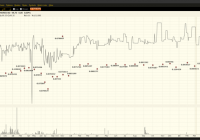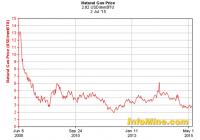A 13.7% Yield From GreenHunter Resources Preferred Shares
GRH’s oilfield waste water disposal business is running at full capacity and expanding rapidly despite low oil and natural gas prices. GRH-PC is a cumulative preferred issue that now yields 13.7%. Gary Evans has successfully built valuable midstream assets at MHR and is doing the same thing at GRH. GreenHunter Resources (NYSEMKT: GRH ) was initially formed by Magnum Hunter founder Gary Evans with the goal of developing alternative energy sources. The company soon realized that biomass and other “green” energy technologies were unprofitable and has exited that business. GRH is now focused on developing cost effective and environmentally friendly oilfield fluid management solutions. GRH-PC is a par $25 cumulative preferred convertible issue. GRH-PC has a 10% coupon and dividends are paid monthly. It now yields 13.7% at a recent price of $18.25. See prospectus for additional details. GRH-PC dividends were classified as Return of Capital for 2014, which provides some tax advantages. ROC dividends lower your cost basis, but are not taxable as income when received. Given that GRH has accumulated substantial tax losses, GRH-PC dividends are likely to remain ROC for quite some time. Why is GRH’s oilfield waste water disposal business running at full capacity (turning away business in fact) even with low oil and natural gas prices? GRH initially developed operations in several regions, but made the wise strategic decision to focus on Appalachia. Disposal wells in other regions were sold and equipment was moved. This resulted in lower Q1 revenues, but paves the way for future profitable growth. Appalachia is a region where the permitting of disposal wells is a difficult and lengthy process. Waste water must often be trucked for long distances at high cost to be properly disposed of. The scarcity of attractively located disposal wells and the difficulty in building more is a key competitive advantage for GRH. Many GRH customers have signed “take or pay” contracts. They are required to pay for access to the company’s disposal capacity, even if they don’t actually use it. GRH serves customers in the Utica and Marcellus fields. These are among the best fields with the highest returns on drilling. Drilling reductions have been less severe for the Utica and Marcellus fields than for other regions with higher production costs. GRH is doing some innovative things that are years ahead of its competitors. Several new disposal wells are coming online over the next few months that are expected to increase their water disposal capacity by about 50%. These wells are being connected to a central offloading terminal by a network of wastewater pipelines. This is an extremely efficient system that will give GRH a significant cost advantage. GRH has also been building a network of barging terminals along the Ohio River and expects to start barging waste water to their central disposal terminal later this year. Barging is a great solution for the pollution and traffic problems associated with trucking. Note that barges are already being used to transport oil and other cargos that are far more hazardous than oilfield water. GRH estimates that barging is about 25% cheaper than trucking. Ironically, barging has been opposed by some “environmentalists.” Some extremists believe we should shut down virtually all oil and natural gas production, but this is just not practical. GRH is developing the right infrastructure for the safe, cost effective and environmentally friendly disposal of waste water. What are the advantages of owning the GRH-PC preferred stock as compared to the GRH common stock? While GRH is building some unique and valuable midstream assets, it’s been a painful growth process for common stockholders. Preferred holders have continued to receive generous monthly dividends while the GRH common has been diluted to raise additional capital. The preferred dividend was maintained even when cash got extremely tight. Fortunately liquidity has improved greatly as GRH closed a new $16 million secured credit facility on 4/15/2015. Cash flow has been challenging for GRH, but should also improve dramatically over the next few quarters as new disposal wells and barging come online. GreenHunter Resources was founded by Gary Evans and he controls a majority of the GRH common stock. The preferred stock is senior to the common stock, so it’s comforting to know that insiders have such a large stake in the company. Gary Evans is better known for founding Magnum Hunter Resources (NYSE: MHR ). MHR also has a strong record of continuing to pay preferred dividends even when liquidity gets tight ( see my recent MHR article ). The MHR preferred issues rallied when MHR announced plans to sell some of their midstream assets for $600 million-$700 million. Many of my newsletter subscribers (see additional article disclosure) are long-time investors in the MHR preferred issues and were not surprised to see Gary Evans come through. GRH-PC is a smaller issue and is not nearly as well known as the MHR preferred issues. Gary Evans has already shown a knack for building valuable midstream assets at MHR and appears to be doing it again at GRH. MHR preferred stock investors should consider the “other” Gary Evans yield play. Editor’s Note: This article covers one or more stocks trading at less than $1 per share and/or with less than a $100 million market cap. Please be aware of the risks associated with these stocks. Disclosure: I am/we are long GRH-PC,MHR-PD. (More…) I wrote this article myself, and it expresses my own opinions. I am not receiving compensation for it (other than from Seeking Alpha). I have no business relationship with any company whose stock is mentioned in this article. Additional disclosure: The author is the publisher of the Panick Value Research Report. The Panick Report is focused on high yield preferred stock issue, email mrpanick@yahoo.com for the 2 week free trial.

